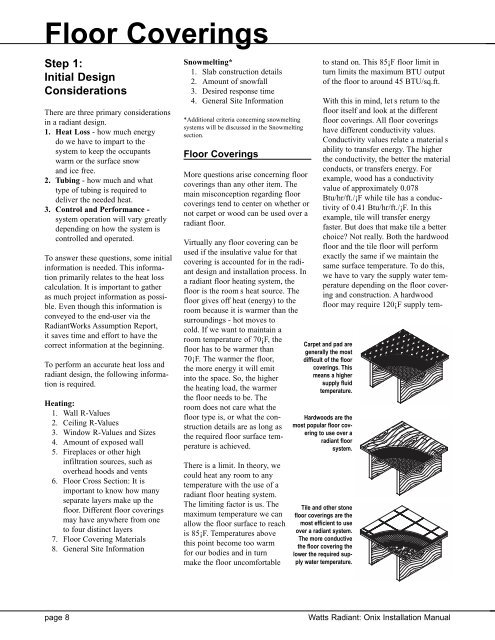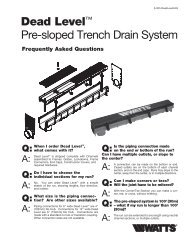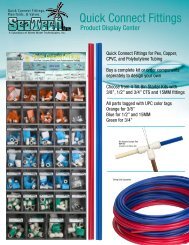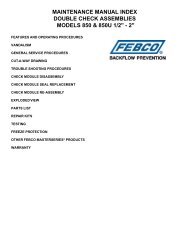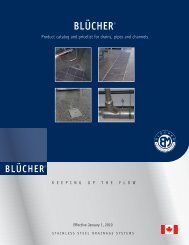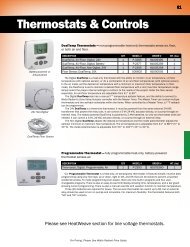Onix Installation Manual.qxd - Affordable Home Inspections
Onix Installation Manual.qxd - Affordable Home Inspections
Onix Installation Manual.qxd - Affordable Home Inspections
- No tags were found...
You also want an ePaper? Increase the reach of your titles
YUMPU automatically turns print PDFs into web optimized ePapers that Google loves.
Floor CoveringsStep 1:Initial DesignConsiderationsThere are three primary considerationsin a radiant design.1. Heat Loss - how much energydo we have to impart to thesystem to keep the occupantswarm or the surface snowand ice free.2. Tubing - how much and whattype of tubing is required todeliver the needed heat.3. Control and Performance -system operation will vary greatlydepending on how the system iscontrolled and operated.To answer these questions, some initialinformation is needed. This informationprimarily relates to the heat losscalculation. It is important to gatheras much project information as possible.Even though this information isconveyed to the end-user via theRadiantWorks Assumption Report,it saves time and effort to have thecorrect information at the beginning.To perform an accurate heat loss andradiant design, the following informationis required.Heating:1. Wall R-Values2. Ceiling R-Values3. Window R-Values and Sizes4. Amount of exposed wall5. Fireplaces or other highinfiltration sources, such asoverhead hoods and vents6. Floor Cross Section: It isimportant to know how manyseparate layers make up thefloor. Different floor coveringsmay have anywhere from oneto four distinct layers7. Floor Covering Materials8. General Site InformationSnowmelting*1. Slab construction details2. Amount of snowfall3. Desired response time4. General Site Information*Additional criteria concerning snowmeltingsystems will be discussed in the Snowmeltingsection.Floor CoveringsMore questions arise concerning floorcoverings than any other item. Themain misconception regarding floorcoverings tend to center on whether ornot carpet or wood can be used over aradiant floor.Virtually any floor covering can beused if the insulative value for thatcovering is accounted for in the radiantdesign and installation process. Ina radiant floor heating system, thefloor is the room s heat source. Thefloor gives off heat (energy) to theroom because it is warmer than thesurroundings - hot moves tocold. If we want to maintain aroom temperature of 70¡F, thefloor has to be warmer than70¡F. The warmer the floor,the more energy it will emitinto the space. So, the higherthe heating load, the warmerthe floor needs to be. Theroom does not care what thefloor type is, or what the constructiondetails are as long asthe required floor surface temperatureis achieved.There is a limit. In theory, wecould heat any room to anytemperature with the use of aradiant floor heating system.The limiting factor is us. Themaximum temperature we canallow the floor surface to reachis 85¡F. Temperatures abovethis point become too warmfor our bodies and in turnmake the floor uncomfortableto stand on. This 85¡F floor limit inturn limits the maximum BTU outputof the floor to around 45 BTU/sq.ft.With this in mind, let s return to thefloor itself and look at the differentfloor coverings. All floor coveringshave different conductivity values.Conductivity values relate a material sability to transfer energy. The higherthe conductivity, the better the materialconducts, or transfers energy. Forexample, wood has a conductivityvalue of approximately 0.078Btu/hr/ft./¡F while tile has a conductivityof 0.41 Btu/hr/ft./¡F. In thisexample, tile will transfer energyfaster. But does that make tile a betterchoice? Not really. Both the hardwoodfloor and the tile floor will performexactly the same if we maintain thesame surface temperature. To do this,we have to vary the supply water temperaturedepending on the floor coveringand construction. A hardwoodfloor may require 120¡F supply tem-Carpet and pad aregenerally the mostdifficult of the floorcoverings. Thismeans a highersupply fluidtemperature.Hardwoods are themost popular floor coveringto use over aradiant floorsystem.Tile and other stonefloor coverings are themost efficient to useover a radiant system.The more conductivethe floor covering thelower the required supplywater temperature.page 8Watts Radiant: <strong>Onix</strong> <strong>Installation</strong> <strong>Manual</strong>


